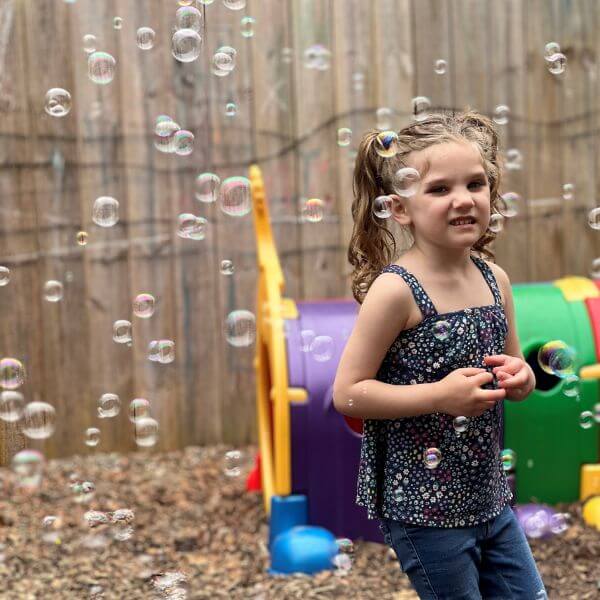What is HRE Within Applied Behavior Analysis? Hopebridge Explains How ‘Happy, Relaxed, Engaged’ Drives Autism Therapy
October 24, 2022
October 24, 2022

“Progress” is a key part of autism therapy. Therapists, families and physicians are often concerned with the progress a child makes during treatment, and while that is a significant piece, at Hopebridge, we have also focused on our own progress and that of the industry’s.
“Hopebridge has been progressive since the beginning. It started in 2005, when Kim Strunk advocated for families to receive insurance coverage for applied behavior analysis, and it’s continued over the years as we expand our knowledge and practices to prioritize happy, relaxed and engaged learners,” said Hopebridge Chief Clinical Officer Jana Sarno. “Though compassionate care has always been the nucleus of our clinical philosophy, enhanced training around our core values helps us continue to drive this home.”

If you’re a clinician or caregiver in the world of autism therapy, you may have heard of “Happy, Relaxed, Engaged” (HRE), also known as the “My Way” approach … but what does it mean and why is it important for our children? Both Jana and our Hopebridge Regional Board Certified Behavior Analyst (BCBA) Taylor Thomas of Florida have hosted CEU events on the topic, and we touched based with them to get more information on how this shift in approach can have a meaningful impact.
This approach stems from Dr. Greg Hanley’s “Today’s ABA” philosophy that a child who is happy, relaxed and engaged is more apt to learn.
The general concept of HRE is fairly basic: Get to a place where the child is most comfortable and prepared to learn. Within ABA, this means finding the right environment and conditions for them. It is making sure they are completely taken care of and that we are building a good relationship with them before we place expectations or work on things that might be difficult for them. For example, do they learn best alongside peers or on their own? Are there certain items that can be available to support them?
Think of your own routines. For an adult, this might look like two cups of coffee, morning yoga and an audio book on the way to work to prepare yourself for the day’s tasks.
HRE places values over procedure. First, we make sure the child is happy, relaxed and engaged, and then we teach around this. It’s all about meeting them where they are at.
HRE is an environmental context that is just one piece of a skill-based treatment (SBT) program. SBT looks at the skills the child needs to be successful and to access to more joy, then breaks the goal down into a task analysis. Rather than relying on too many supports to set up a “perfect” scenario that a parent or teacher may not be able to carry over, SBT allows us to build a strong foundation that rests on communication, tolerating denial and delays to reinforcers. Doing so enables us to generalize this set of pivotal skills and then build onto it.
To Taylor, the main reason why Hopebridge focuses on the happy, relaxed and engaged approach is logical.

“If we have the tools and training, why wouldn’t we move in this direction? Studies show it is just as effective (Fiani & Jessel, 2022; Iannaccone & Jessel, 2020; Rajaraman & Hanley, 2021), so let’s continue toward even more compassionate care approaches.” said Taylor.
Taylor and Jana want others to know that therapy shouldn’t feel like drudgery work for anyone involved. Instead, working with concepts like HRE shows that a softer side to therapy produces better results.
“ABA is an ever-evolving science, and we are shifting along with our field. It’s not that it was wrong before, it’s just that we know more now. HRE comes out of a trauma-informed, do-better movement. How can we be even safer, more effective, more dignified and more trustworthy for our kids and families?” said Jana. “With this comes so much joy, but it also helps us create many more individualized learning opportunities.”
Not only does having a willing, able and relaxed learner make the experience better for the child, but it can also help them reach their goals.
“Our data, research and practice are all better now. As clinicians, we have greater tools to move forward in this way. Some of the practices from the past are simply not necessary now that we know more,” said Taylor.

Another difference between the HRE community and the more traditional ABA community is around the idea of reinforcement. From the HRE perspective, Dr. Hanley noted that reinforcement isn’t something you can hold in your hand. Traditional ABA might use half a Skittle and praise as reinforcement, whereas in HRE, it’s the entire context; it’s everything that comes together for the child to be happy, relaxed and engaged.
“Wanting a child to be happy is not new, but the overall HRE context is new,” said Taylor. This is where an individual can be as autistic as they want to be.
“They can rock, flap or stim, if they want. Sometimes, traditional ABA practices might focus on removing stereotypy and replacing it with something else, but we know from the autism community that many people enjoy it. We all do things that are self-stimulatory, but individuals with autism might do it in a more exaggerated manner. A key piece of HRE is understanding that others’ reinforcement doesn’t need to look like what my idea of reinforcement should be, which may be void of stimming.”

Has the idea of happy, relaxed and engaged children piqued your interest in this type of care? We hope so! This post is just one piece of a three-part series on HRE, so stay tuned to find out more about its implementation and its benefits from a family’s perspective.
If you are interested in joining Hopebridge’s mission as a clinician while developing your own career, check out our open positions in locations across the country.
For caregivers interested in finding out more about Hopebridge’s compassionate care and clinical excellence, reach out to us for information on how our autism testing and individualized therapy programs can benefit your child.
Fiani, T. & Jessel, J. (2022). Practical Functional Assessment and Behavioral Treatment of Challenging Behavior for Clinically Based Outpatient Services: A Consecutive Case Series Evaluation. Association for Behavior Analysis International, https://doi.org/10.1007/s43494-022-00071-9.
Iannaccone, J.A. & Jessel, J. (2020). A translational comparison of contingency-based progressive delay procedures and their effects on contextually appropriate behavior. Journal of Applied Behavior Analysis, 9999, 1-17.
Rajaraman, A. & Hanley, G.P. (2021). Mand compliance as a contingency controlling problem behavior: A systematic review. Journal of Applied Behavior Analysis, 54, 103-121.
*Informed consent was obtained from the participants in this article. This information should not be captured and reused without express permission from Hopebridge, LLC.